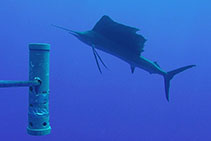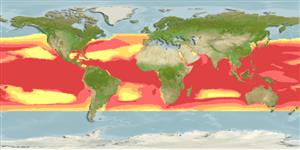|
| Links |
We parsed the following live from the Web into this page. Such content is managed by its original site and not cached on Discover Life. Please send feedback and corrections directly to the source. See original regarding copyrights and terms of use.
- Australian Faunal Directory
- FishBase
|
|
español |
|
|
Overview |
Main identification features
- 1st dorsal fin : large long sail
- pelvics very long, thin
A tall, long-based, sail-like dorsal fin with 42-49 rays and small second dorsal fin with 6 or 7 rays; 2 anal fins, the first with 12-17 rays and second with 6-7 rays; pectoral rays 18-20; pelvic fins extremely long, almost reaching anus, depressible into a groove; sword round.
Dark blue dorsally, light blue blotched with brown laterally, and silvery white ventrally; about 20 rows of vertical bars on sides, each composed of many light blue round spots; membrane of first dorsal fin dark blue or blackish blue, with scattered, small black spots; remaining fins blackish brown to dark blue.
Size: grows to 360 cm; all-tackle world record 100.24 Kg.
Habitat: coastal and oceanic pelagic.
Depth: 0-30 m.
Indo-Pacific in tropical and temperate seas; southern California to the lower 3/4 of the Gulf of California to Peru and the oceanic islands.
Attributes
Abundance: Common.
Cites: Not listed.
Climate Zone: North Temperate (Californian Province &/or Northern Gulf of California); Northern Subtropical (Cortez Province + Sinaloan Gap); Northern Tropical (Mexican Province to Nicaragua + Revillagigedos); Equatorial (Costa Rica to Ecuador + Galapagos, Clipperton, Cocos, Malpelo); South Temperate (Peruvian Province ).
Depth Range Max: 30 m.
Depth Range Min: 0 m.
Diet: Pelagic crustacea; bony fishes; octopus/squid/cuttlefish.
Eastern Pacific Range: Northern limit=40; Southern limit=-40; Western limit=-124; Eastern limit=-73; Latitudinal range=80; Longitudinal range=51.
Egg Type: Pelagic; Pelagic larva.
Feeding Group: Carnivore.
FishBase Habitat: Pelagic.
Global Endemism: All Pacific (West + Central + East); Indo-Pacific only (Indian + Pacific Oceans); TEP non-endemic; "Transpacific" (East + Central &/or West Pacific); All species.
Habitat: Water column.
Inshore Offshore: Offshore; Offshore Only.
IUCN Red List: Not evaluated / Listed.
Length Max: 360 cm.
Regional Endemism: Island (s); Continent; Continent + Island (s); Tropical Eastern Pacific (TEP) non-endemic; Eastern Pacific non-endemic; All species.
Residency: Resident.
Salinity: Marine; Marine Only.
Water Column Position: Mid Water; Near Surface; Surface; Water column only;
|
|
|
Names | |
|
|
|
Links to other sites | |
|
|
|
References |
- Acero, A. and Franke, R., 2001., Peces del parque nacional natural Gorgona. En: Barrios, L. M. y M. Lopéz-Victoria (Eds.). Gorgona marina: Contribución al conocimiento de una isla única., INVEMAR, Serie Publicaciones Especiales No. 7:123-131.
- Béarez, P., 1996., Lista de los Peces Marinos del Ecuador Continental., Revista de Biologia Tropical, 44:731-741.
- Castro-Aguirre, J.L. and Balart, E.F., 2002., La ictiofauna de las islas Revillagigedos y sus relaciones zoogeograficas, con comentarios acerca de su origen y evolucion. En: Lozano-Vilano, M. L. (Ed.). Libro Jubilar en Honor al Dr. Salvador Contreras Balderas., Universidad Autonoma de Nuevo León:153-170.
- Eschmeyer , W. N. , Herald , E. S. and Hamman, H., 1983., A field guide to Pacific coast fishes of North America from the Gulf of Alaska to Baja California. Peterson Field Guide Ser. 28., Houghton Mifflin:336pp.
- Findley, L.T., Hendrickx, M.E., Brusca, R.C., van der Heiden, A.M., Hastings, P.A., Torre, J., 2003., Diversidad de la Macrofauna Marina del Golfo de California, Mexico., CD-ROM versión 1.0. Projecto de la Macrofauna del Golfo . Derechos reservados de los autores y Conservación Internacional.
- Fowler, H.W., 1944., Results of the Fifth George Vanderbilt Expedition (1941) (Bahamas, Caribbean sea, Panama, Galapagos Archipelago and Mexican Pacific Islands). The Fishes., Acad. Nat. Sci. Philadel., Monographs, 6:57-529.
- Franke , R. and Acero P., A., 1996., Peces óseos comerciales del Parque Gorgona, Pacífico colombiano (Osteichthyes: Muraenesocidae, Hemiramphidae, Belonidae, Scorpaenidae, Triglidae, Malacanthidae, Gerridae, Sparidae, Kyphosidae, Sphyraenidae e Istiophoridae)., Revista de Biologia Tropical, 44:763-770.
- Galván-Magaña, F., Gutiérrez-Sánchez, F., Abitia-Cárdenas, L.A., Rodríguez-Romero, J., 2000., The distribution and affinities of the shore fishes of the Baja California Sur lagoons. In Aquatic Ecosystems of Mexico: Status and Scope. Eds. M. Manuwar, S.G. Lawrence, I.F. Manuwar & D.F. Malley. Ecovision World Monograph Series., Backhuys Publishers:383-398.
- Graves , J. E. and McDowell, J. R., 1995., Inter-ocean genetic divergence of istiophorid billfishes., Marine Biology, 122:193-203.
- Grove , J.S. and Lavenberg, R. J., 1997., The fishes of the Galápagos islands., Stanford University Press:863 pp.
- Jimenez-Prado, P., Béarez, P., 2004., Peces marinos del Ecuador continental / Marine fishes of continental Ecuador., SIMBIOE/NAZCA/IFEA tomo 1 y 2.
- Joseph , J. , Klawe , W. and Murphy, P., 1988., Tuna and Billfish - fish without a country., Inter-American Tropical Tuna Commission:69.
- Lopez , M. I. and Bussing, W. A., 1982., Lista provisional de los peces marinos de la Costa Rica., Revista de Biologia Tropical, 30(1):5-26.
- Love, M.S., Mecklenburg, C.W., Mecklenburg, T.A., Thorsteinson, L.K., 2005., es of the West Coast and Alaska: a checklist of North Pacific and Artic Ocena species from Baja California to the Alaska-Yukon border., U.S. Department of the Interior, U.S. Geological Survey, Biological Resources Division, 288pp.
- Madrid Vera , J. , Ruíz Luna , A. and Rosado Bravo, I., 1998., Peces de la plataforma continental de Michoacán y sus relaciones regionales en el Pacífico mexicano., Revista de Biologia Tropical, 42(2):267-276.
- Molina, L., Danulat, E., Oviedo, M., González, J.A., 2004., Guía de especies de interés pesquero en la Reserva Marina de Galápagos., Fundación Charles Darwin / Agencia Espeñola de Cooperación Internacional / Dirección Parque Nacional Galápagos, 115pp.
- Nakamura,., 1985., Billfishes of the world. An annotated and illustrated catalogue of marlins, sailfishes, spearfishes and swordfishes known to date. FAO species catalogue Vol. 5., FAO Fish. Synop. No 125, 125.
- Ramírez Rodríguez, M., 1997., Producción pesquera en la Bahía de La Paz, B.C.S.. En Urbán Ramírez, J. y M. Ramírez Rodríguez (Eds.). La Bahía de La Paz investigación y conservación., Universidad Autónoma de Baja California Sur:273-282.
- Ricker, K.E., 1959., Mexican shore and pelagic fishes collected from Acapulco to Cape San Lucas during the 1957 cruise of the "Marijean"., Univ. Brit. Columbia Inst. Fish., Mus. Contrib., 3:18pp.
- Shaw , G. and Nodder, F. P., 1813., The Naturalist's Miscellany, or coloured figures of natural objects; drawn and described from nature. London., Naturalist's Misc., :unnumbered pages.
- Van der Heiden , A. M. and Findley, L. T., 1988., Lista de los peces marinos del sur de Sinaloa, México., Anales del Centro de Ciencias del Mar y Limnologia de la Universidad Autonoma Nacional de Mexico, 15:209-224.
|
|
|
Acknowledgements | |
I thank Ashley MacDonald and John Pickering, University of Georgia, for technical support in building this page.
|
|
| Supported by | |
|
Following modified from Australian Faunal Directory
|
Top | See original
| &pull 20q v5.145 20180528: Error 301 Moved Permanently http://biodiversity.org.au/afd/taxa/8c378113-b081-4e11-9be4-e7a954cda5e3 |
|
Following modified from FishBase
|
Top | See original
http://www.fishbase.org/Summary/speciesSummary.php?genusname=Istiophorus&speciesname=platypterus ---> http://192.134.151.83/Summary/speciesSummary.php?genusname=Istiophorus&speciesname=platypterus
http://192.134.151.83/Summary/speciesSummary.php?genusname=Istiophorus&speciesname=platypterus ---> https://fishbase.mnhn.fr/Summary/speciesSummary.php?genusname=Istiophorus&speciesname=platypterus
https://fishbase.mnhn.fr/Summary/speciesSummary.php?genusname=Istiophorus&speciesname=platypterus ---> https://fishbase.mnhn.fr/summary/Istiophorus-platypterus.html
Istiophorus platypterus, Indo-Pacific sailfish

You can
sponsor
this page
Common name (e.g. trout)
Genus + Species (e.g. Gadus morhua)
-

-
About this page
-
Languages
-
User feedbacks
-
Citation
-
Uploads
-
Related species
-


 Indo-Pacific sailfish
Add your observation in
Fish Watcher
Upload your
photos
and
videos
Indo-Pacific sailfish
Add your observation in
Fish Watcher
Upload your
photos
and
videos
Pictures
|
Stamps, Coins Misc.
|
Google image
 Istiophorus platypterus
Istiophorus platypterus
Picture by
University of Western Australia (UWA)
Teleostei (teleosts) >
Carangiformes
(Jacks) >
Istiophoridae
(Billfishes)
Etymology:
Istiophorus:
Greek, istios = sail + Greek, pherein = to carry (Ref.
45335
)
.
More on author:
Shaw
.
Environment: milieu / climate zone / depth range / distribution range
Size / Weight / Age
Maturity: L
m
?
range ? - ? cm
Short description
Morphology
|
Morphometrics
Dorsal
spines
(total): 0;
Dorsal
soft rays
(total): 47-53;
Anal
spines
: 2;
Anal
soft rays
: 12 - 15. This species is distinguished by the following characters: slender elongate and fairly compressed with a high, sail-like first dorsal fin; upper jaw prolonged into a very long beak, slender and round in cross-section; jaws and palatines with villiform teeth; no gill rakers; two dorsal fins, the first very large (42-49 rays) the second small (6-7 rays); pectoral fins 18-20 rays; pelvic fins I, 2 soft rays fused together, very long and narrow, depressible into a groove; caudal peduncle with double keels on each side; body covered with small, embedded scales with 1 or 2 blunt points. Colour of back dark with about 20 bluish vertical bars; belly pale silver; membrane of first dorsal fin blue- black with numerous dark spots; bases of first and second anal fins often tinged with silvery white; remaining fins blackish brown or dark blue (Ref.
43
,
26938
).
Life cycle and mating behavior
Nakamura, I.
, 1985. FAO species catalogue. Vol. 5. Billfishes of the world. An annotated and illustrated catalogue of marlins, sailfishes, spearfishes and swordfishes known to date. FAO Fish. Synop. 125(5):65p. Rome: FAO. (Ref.
43
)
IUCN Red List Status (Ref.
130435
)
CITES
Not Evaluated
Not Evaluated
Threat to humans
Human uses
FAO - Fisheries:
landings
,
species profile
; Publication:
search
|
FishSource
|
More information
Countries
FAO areas
Ecosystems
Occurrences
Introductions
Stocks
Ecology
Diet
Food items
Food consumption
Ration
Common names
Synonyms
Metabolism
Predators
Ecotoxicology
Reproduction
Maturity
Spawning
Spawning aggregation
Fecundity
Eggs
Egg development
Age/Size
Growth
Length-weight
Length-length
Length-frequencies
Morphometrics
Morphology
Larvae
Larval dynamics
Recruitment
Abundance
BRUVS
References
Aquaculture
Aquaculture profile
Strains
Genetics
Electrophoreses
Heritability
Diseases
Processing
Nutrients
Mass conversion
Collaborators
Pictures
Stamps, Coins Misc.
Sounds
Ciguatera
Speed
Swim. type
Gill area
Otoliths
Brains
Vision
Tools
E-book
|
Field guide
|
Identification keys
|
Length-frequency wizard
|
Life-history tool
|
Point map
|
Classification Tree
|
Catch-MSY
|
Special reports
Check for Aquarium maintenance
|
Check for Species Fact Sheets
|
Check for Aquaculture Fact Sheets
Download XML
Summary page
|
Point data
|
Common names
|
Photos
Internet sources
AFORO (otoliths) |
Aquatic Commons
|
BHL
|
Cloffa
|
BOLDSystems
|
Websites from users
|
Check FishWatcher
|
CISTI
|
Catalog of Fishes
:
genus
,
species
|
DiscoverLife
|
ECOTOX
| FAO - Fisheries:
landings
,
species profile
; Publication:
search
|
Faunafri
| Fishipedia |
Fishtrace
| GenBank:
genome
,
nucleotide
|
GloBI
|
GoMexSI
(interaction data)
|
Google Books
|
Google Scholar
|
Google
| IGFA World Record |
MitoFish
|
National databases
|
Otolith Atlas of Taiwan Fishes
|
PubMed
| Reef Life Survey | Socotra Atlas |
Tree of Life
| Wikipedia:
Go
,
Search
| World Records Freshwater Fishing |
Zoological Record
Estimates based on models
Preferred temperature (Ref.
123201
): 18.2 - 27.7, mean 25.6 °C (based on 513 cells).
Phylogenetic diversity index (Ref.
82804
): PD
50
= 0.7505 [Uniqueness, from 0.5 = low to 2.0 = high].
Bayesian length-weight: a=0.00589 (0.00276 - 0.01257), b=3.14 (2.94 - 3.34), in cm total length, based on LWR estimates for this species & (Sub)family-body (Ref.
93245
).
Trophic level (Ref.
69278
): 4.5 ±0.3 se; based on diet studies.
Prior r = 0.28, 95% CL = 0.16 - 0.49, Based on 3 stock assessments.
Nutrients (Ref.
124155
): Calcium = 26.2 [12.9, 42.4] mg/100g; Iron = 0.856 [0.511, 1.406] mg/100g; Protein = 19.6 [18.4, 20.6] %; Omega3 = 0.209 [0.114, 0.374] g/100g; Selenium = 44.7 [23.7, 83.1] μg/100g; VitaminA = 6.44 [2.15, 18.92] μg/100g; Zinc = 0.364 [0.257, 0.521] mg/100g (wet weight);
Back to Search
Random Species
Back to Top
Accessed through:
Not available
FishBase mirror site :
localhost
Page last modified by :
mrius-barile
- 20 July 2016
Fatal error
: Uncaught ArgumentCountError: Too few arguments to function checkEcotox(), 1 passed in /var/www/html/summary/speciessummary.php on line 2304 and exactly 3 expected in /var/www/html/includes/speciessummary.lib.php:2579 Stack trace: #0 /var/www/html/summary/speciessummary.php(2304): checkEcotox() #1 {main} thrown in
/var/www/html/includes/speciessummary.lib.php
on line
2579
|
Updated: 2024-05-23 05:58:12 gmt
|







